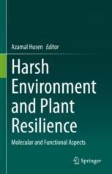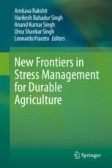Search
Search Results
-
High-Throughput Phenomics of Crops for Water and Nitrogen Stress
While both water and nitrogen (N) are necessary for crop output and quality, excessive N application increases production costs and environmental...
-
Omics Technology for Plant Stress Management
Plants are biosystems, they made-up with cells, which are responsible for all biological actions as well as responding to their micro- and...
-
Speed Breeding: A Budding Technique to Improve Crop Plants for Drought and Salinity Tolerance
The present dynamic climate conditions would escalate various abiotic stresses in crop plants such as drought, salinity, heat, mineral toxicity, etc....
-
Modification of starch content and its management strategies in plants in response to drought and salinity: current status and future prospects
Starch is a type of carbohydrate commonly stored in plants and is one of the primary sources of energy in food for human beings. Starch comprises a...

-
OMICS Tools and Techniques for Study of Defense Mechanism in Plants
In recent times, agriculturally important plants face increasing challenges in maintaining productivity, disease control, and welfare of farmers with...
-
Multi-Omics Approaches for Breeding in Medicinal Plants
Over the last few eras, multi-omics has been a successful technique for medicinal plants. All over the medicinal plants have been operated in...
-
Screening of salt-tolerant wheat (Triticum aestivum L.) through morphological and molecular markers
Screening of wheat genotypes containing suitable candidate genes for salt tolerance is an essential step in stress-breeding. This study aimed to...

-
Plant phenomics: High-throughput technology for accelerating genomics
Plant phenomics is a high-throughput path-breaking area that meets all the requirements for the collection of accurate, rapid and multi-faceted...

-
Strategies to Develop Heat and Drought–Tolerant Wheat Varieties Following Physiological Breeding
Worldwide, abiotic stresses including heat and drought are the major obstructions that threaten the agricultural production. Development of...
-
How Genome Editing Can Be Helpful in the Biofortification of Legumes
Legumes are consumed as a staple food in low-income countries to meet growing nutritional demands and are used as rich sources of protein and...
-
Dissection of Physiological and Biochemical Bases of Drought Tolerance in Soybean (Glycine max) Using Recent Phenomics Approach
Soybean is globally a promising oilseed legume providing quality protein and edible oil for human consumption and animal feed, besides supplying...
-
Data challenges for future plant gene editing: expert opinion
Agricultural data in its multiple forms are ubiquitous. With progress in crop and input monitoring systems and price reductions over the past decade,...
-
Genomics Assisted Breeding for Sustainable Agriculture: Meeting the Challenge of Global Food Security
Increasing global population coupled with climate change has become a big challenge for the plant breeders and researchers to ensure the food...
-
Advancement in Molecular and Fast Breeding Programs for Climate-Resilient Agriculture Practices
Under the climate change scenario, the intensities and unpredictability of various abiotic and biotic stress factors are increasing remarkably. In...
-
Phenomics-Assisted Breeding: An Emerging Way for Stress Management
The challenges posed by several known and unknown biotic and abiotic stresses arising due to increasing population, global warming, and other...
-
Breeding and Omics Approaches to Understand Abiotic Stress Response in Rice
Rice (Oryza sativa L.) is the major sources of food and calories for more than half of the world population. Productivity of rice is adversely...
-
Genomic Selection for Wheat Improvement
Recent advances in plant breeding and agronomic practices have contributed significantly to the annual genetic gain in crop productivity to the tune...
-
Role of Biotechnology in Climate Resilient Agriculture
“Resilience of agriculture to climate change” is a serious matter that should be the focus of all scientific, economic, political and social...
-
Genomic Design for Abiotic Stress Resistance in Pigeonpea
Pigeonpea is a versatile food grain that grows in the regions of tropical and subtropical climates. Biotic and abiotic factors have a big impact on...
-
Drought Stress in Chickpea: Physiological, Breeding, and Omics Perspectives
Chickpea (Cicer arietinum L.) is a highly rich source of protein and is documented as the second most valuable food legume worldwide. In rain-fed...
